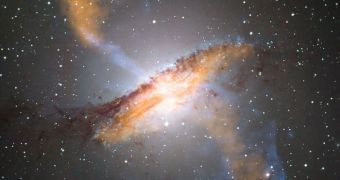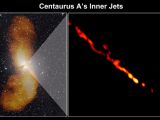Using several ground- and space-based telescopes, astronauts were recently able to capture the most impressive view ever of the supermassive black hole that powers up the galaxy Centaurus A.
Also known as NGC 5128, the prominent space structure is located in the constellation of Centaurus. Estimates on the distance separating it from our galaxy range between 10 and 16 million light-years.
The international astronomical community has yet to establish for certain whether the structure is a lenticular galaxy or a giant elliptical galaxy. What they do know for certain is that it emits vast amounts of radio radiation, in addition to other types of light.
It features an active galactic nucleus, which is powered by a supermassive black hole. What separate this dark behemoth from others is the fact that it produces a pair of relativistic particle jets, which extend for as much as 1 million light-years out into space.
The second image attached to this article shows the most recent view astronomers were able to obtain of these jet. The data was collected in radio wavelengths by an array of radio telescopes, experts say.
The international team of astronomers focused on an area about 4.2 light-years across, in which they were able to make out details that were as small as 15 light-days. These are therefore the highest resolution images ever obtained of Centaurus A's particle jets.
This study was carried out using an intercontinental array of nine radio telescopes known as the Tracking Active Galactic Nuclei with Austral Milliarcsecond Interferometry (TANAMI) project.
“These jets arise as infalling matter approaches the black hole, but we don’t yet know the details of how they form and maintain themselves,” explains study researcher Cornelia Mueller.
The investigator is the lead author of a new study detailing the findings, and also a doctoral student at the University of Erlangen-Nuremberg, in Germany, Universe Today reports.
At this point, astrophysicists don't yet know for sure how or why black hole jets form. There are several theories explaining the phenomenon, but more evidence is needed to support either of them.
In the case of Centaurus A, the radio jets were found to be racing away from the black hole at one third the speed of light. It could be that the supermassive black hole is surrounded by an accretion disk.
This structure takes matter and starts whirling it around the black hole, causing tremendous friction and heat within. This process may be responsible for the generation of such high volumes of radiation.

 14 DAY TRIAL //
14 DAY TRIAL // 
